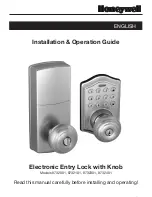
step 12
Before closing the door,
enter the code and check that
the latchbolt will retract when
the lever handle is depressed.
Now check the operation of
the inside lever handle. If there
is any binding of the handles
or the latch then loosen the
bolts and reposition the plates
slightly until the correct
position is found, and then
re-tighten the bolts.
step 13
Fit the double Euro-profile
cylinder and secure it with
the long screw through the
faceplate. Fit the cylinder
escutcheons.
step 14
Check that the deadbolt will
project and retract by key,
and that the key will also
retract the latchbolt.
Check that the inside lever
handle WILL retract the
deadbolt simultaneously with
the latchbolt.
Check that the outside lever
handle WILL NOT retract the
deadbolt.
step 15
Mark a vertical line on the door
jamb half the door thickness
away from the door stop. This
gives the centre line of the
strike plate. Align the Strike
Plate Template with the height
line, with the arrow heads
aligned with the centre line.
Mark the fixing holes, and draw
around the apertures for the
latchbolt and the deadbolt.
Chisel out the latch aperture to
12mm deep, and the deadbolt
aperture to 22mm deep.
Fix the strike plate with the top
screw only and gently close the
door. Ensure that the latchbolt
enters its aperture easily and
holds the door without too much
‘play’. When satisfied, draw
around the final position of the
strike plate, remove it, and cut a
rebate to allow it to fit flush to
the surface. Re-fix the strike with
both screws.
step 9
Check that the lever handles
are correctly fitted for the
hand of door. To change the
hand of a lever handle, loosen
the grub screw with the small
Allen key, reverse the lever
handle and fully tighten the
grub screw.
step 10
Apply the front and back
plates, with the neoprene
seals in position, against the
door, over the protruding
ends of the spindle.
step 11
Fix the two plates together
using the socket head bolts,
starting with the top fixing.
Ensure that the two plates are
truly vertical and then tighten
the bolts using the ‘T’ shaped
Allen key. Do not use
excessive force.
step 5
Drill the holes from both sides
of the door to improve
accuracy and to avoid
splintering out the door face.
step 4
Fold the template accurately
along the dotted line and tape it
to the door face with the top in
line with the height line, and the
fold on the door edge. Mark the
centres of all the holes to be
drilled. Remove the template
and repeat the procedure on the
other face of the door.
step 3
Apply tape to the 16mm drill
bit at 90mm from the tip to
act as a depth guide when
drilling the mortice holes.
Ensure the drill is level and
parallel to the door face and
drill the holes as indicated on
the template. Remove the
remaining wood with a chisel
to leave a clean mortice hole
which accepts the lockcase
without forcing. With the lock
in the mortice make sure that
the forend is parallel with the
door edge and mark the
outline of the forend plate.
Cut the outline with a Stanley
knife to avoid splitting out
when chiselling. Chisel a
rebate sufficient to accept the
forend flush with the surface.
22mm bolt throw
Bolt through fixings
for lever furniture
Grub screws
Split follower
Bolt through fixings
for escutcheons
Easy to reverse
key action latchbolt
FIGURE 2
520/525 lockcase
step 1
Lightly mark a height line on
the edge and both faces of the
door, and the door jamb, to
indicate the top of the lock
when fitted. Mark a line down
the centre of the door edge,
extending above the height line
and 300mm below it.
step 2
Hold the template against the
edge of the door with the top
in line with the height line, and
with the arrows in line with the
‘Centre of Door Edge’ line.
Mark the positions of the
fixing screws, and the holes
to be drilled for the mortice.
step 8
Take the 2-part spindle, with
the springs in place. Note that
one has a RED coloured face,
and the other a BLUE face. If
your door is hinged on the
right, viewed from outside, then
fit the BLUE spindle to the latch
follower on the outside, with
the colour on TOP. Fit the RED
spindle to the inside, again with
the colour on TOP.
For a left hand hung door fit the
spindles the other way around,
with the colours on TOP.
step 6
Install the lockcase in the door.
step 7
Cut two of the black socket
head bolts to the required
length for your door.
Approximate overall length
should be door thickness plus
25mm to allow about 10mm of
threaded bolt to enter the
outside plate.
























